- TOP
- List of Projects
- Early Disease Onset Detection at Home Project
Early Disease Onset Detection at Home Project

- Project Summary
-
In Japanese society, we are experiencing a trend of having an increasing number of patients with cardiovascular diseases. Among cardiovascular diseases, strokes have been reported to occur at home 79% of the time. This means that it is important to achieve early detection of disease onset for diseases and to ensure prompt treatment.
If early detection is achieved, we calculate that up to 3 trillion yen, which is approximately 23 billion US dollars, will be saved in social costs related to death and occurrence of permanent damage.
We are currently working on building a one-stop service from early detection to prompt treatment with a house manufacturer, specialists, and many other collaborative corporations.
Background of the Problem
The rate of aging for Japan’s population is the world’s highest at 28.8% (as of 2020), and it is predicted that it will reach 33.3% by 2036, which means one in three people will be 65 years of age or older. As one of the issues aging societies would be faced, we predict a lack of nursing-care personnel, and national financial pressure due to increased medical and nursing care costs.We will also have another issue in that there will be an increasing number of patients with cardiovascular diseases. Of the cardiovascular diseases, it is reported that 79% of strokes and 67% of myocardial infarction happen at home.
Analysis of the Problem Mechanism
There is a treatment called tPA therapy for strokes that can only be administered within 4.5 hours of the occurrence of the stroke. Even though treatment and emergency transport systems are being developed to clear the above time constraint, research shows that only about 5% of eligible stroke patients receive the administration of tPA due to delays in detection or uncertainty over the time of occurrence. This means that the bottleneck is the fact that a system for early detection of disease onset has yet to be organized.
Design of the Solution
We conceptualized a one-stop solution that automatically detects a dangerous condition and achieves prompt treatment by applying technologies to accidents and disease onsets that tend to happen at home.According to a calculation we did with the cooperation of a national research institute, if we could detect strokes early and achieve prompt treatments, we would be able to reduce social costs, which include medical expenses, nursing care expenses, and amount of labor opportunity loss by individuals and companies, by approximately 690-890 billion yen, which is about 5.3-6.8 billion US dollars.
Moreover, if myocardial infarctions, drowning, trips, and falls could be added to the system, it would be able to reduce up to 3 trillion yen, which is approximately 23 billion, in the social costs.
Strategic Partnering
Taking lead with the house manufacturer who agrees with the significance of the early detection at home, we are building the early detection system with the cooperation of many multiple domestic leading companies, specialists from the medicine and engineering fields, and prestigious foreign research institutes.
Project Management
While benefitting the power of various expert players, we have been working on the project separated into specific roles such as a team to explore technologies, a team to conduct validation experiments in a lab, a team to pursue evidence from the viewpoint of the medical field, and a team to build the system.
All of us have been committing as one big project team towards achieving the implementation of the system.
- Digital Health
- Disease Awareness/Disease Prevention
- Advanced Medical Technology
- The 100-year Life
- SDGs/ESG
- Food Loss Reduction/Food Safety and Security
- Smart Cities
- Decarbonization/Carbon Neutrality
- Reconstruction Assistance
- Infection Control Measures
- Tourism
- Disaster Management (Prevention and Mitigation)
- Regional Revitalization